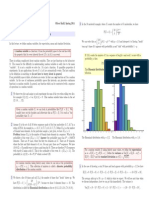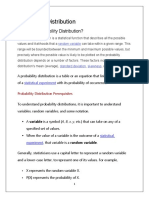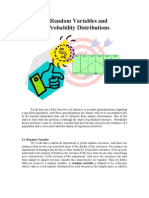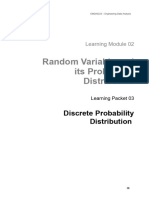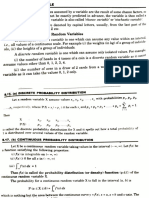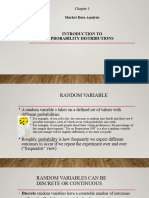0 ratings0% found this document useful (0 votes) 79 views24 pages5 - Jan10 Discrete Random Variable
Copyright
© © All Rights Reserved
We take content rights seriously. If you suspect this is your content,
claim it here.
Available Formats
Download as PDF or read online on Scribd
Starter:
Quiz
~ 7 minutes
No calculator�Unit 6 - Probability & Probability Distributions
Probability Laws
Bayes Theorem
Permutations & Combinations
Basic statistics review
Discrete Random Variables
Expectation Algebra
Binomial Distribution
Continuous Random Variables
Normal Distribution
Valid Comparisons & Informed Decisions�‘A casino offers a game where a coin is tossed repeatedly. If the first head occurs on the
first throw you get £2, ifthe first head occurs on the second throw you get £4, if the first
head is on the third throw you get £8, and so on with the prize doubling each time. How
much should the casino charge for this game if they want to make a profit?
E. ih o> Would you play this game?
a
[ee
pT le�Roll two tetrahedral dice. Find the probability
that the difference between the scores is one.
The above situation is an example of a random experiment in which the values of the differences
between the scores are its associated random variable. The probability that each numerical value
of the random variable occurs is the probability distribution of the random variable.
a AA�A random variable represents in number form the possible outcomes which could
occur for some random experiment.
A discrete random variable X has possible values 21, <2, 23,
Forexample: © the number of houses in your suburb which have a ‘power safety switch’
© the number of new bicycles sold each year by a bicycle store
© the number of defective light bulbs in the purchase order of a city store.
A continuous random variable X has all possible values in some interval on the number
line.
For example: ¢ the heights of men could all lie in the interval 50 < x < 250 cm
‘© the volume of water in a rainwater tank during a given month could lie
in the interval 0 < x < 100 m’.
To determine the value of a discrete random variable we need to count.
To determine the value of a continuous random variable we need to measure.�Classify the followi
Fe neon
random variables as continuous or discrete: Discuss in your groups:
the quantity of fat in a sausage
for a geography test
the weight of a seventeen year old student
the mark out of 5
the volume of water in a cup of coffee
the number of trout in a lake
the number of hairs on a cat
the length of hairs on a horse
the height of a sky-scraper.
hits shvww gimkit comew'63 te6da3 150970021d2ba91 _htps:dashboard blooket com/set61790783cSaee20917astesd
Data Types
(Nominal, Ordinal,
Discrete, Continuous)
types of data sete
byDavidS�For each random variable there is a probability distribution.
The probability distribution of a diserete random variable can be given
in table form
in graphical form
‘¢ in functional form as a probability mass function.
It provides us with all possible values of the variable and the probability of the occurrence of
each value.�The list of all values in the sample space of a random variable,
together with their corresponding probabilities, is called the
probability distribution or probability mass function of the
variable; this information is often best displayed in a table.
‘Draw a table to show the probability mass function of the outcomes ofa
For any random variable there is a corresponding probability distribution.
The probability that the variable X takes value « is written as P(X =r) or pe. We can
also sometimes write a probability distribution as a function P(.r).
For example, when tossing two coins, the random variable X could be 0 heads, 1 head, or
2 heads, ie, X =0,1or2. The associated probability distribution is po = }, pi = 3.
and p2 = with graph:
sf probability
4
Pe HOMEniMCeaRaasiat
Tuber of heads�Roll two unbiased cubical dice once and note the difference between the scores on the dice.
Xx 0 1 2 3 4 5
Px
Roll an unbiased tetrahedral die three times and note the number of times a score of “4” is
obtained.
x 0 1 p at]
P.
Roll an unbiased tetrahedral die until a score of “4” is rolled and note the number of rolls of
the die needed to get this score of “4”.
xX 1 2 z] 4 5 n
Py�x 0 1 2 3 4 5
P iG: 10 3 Ss a: 2
* 36 36 36 36 36 36
Note that }" p, =1 as required.
xe 0 1 2 3
27 27 9 1
Ps a | o« | «|
Note: This is an example of a well-known probability model — The Binomial Distribution.
It will be studied in detail in a later section.
X 1 2 3 4 5 n
® |a |e | @ (QO
Note: This is an example of a well-known probability model - The Geometric Distribution.
It, too, will be studied in detail.�State clearly what the random variable represents.
b Find I k i P(X 22). ii PA8|D>6). =�‘© a Tae random vara ropes he mb of it hat Sly as i ech me
Xa OLLI OS
© 1 oor +o1e++046-+008+0,
to Enxen
eo Solutions
eo
a nea mw macxcs
ARX=2 a Xa3 @ Xad oe X=5) Pu) + Pa) + PO)
Pla) PO) +P) + PS) oue+o23 +048
28-046 008+ 002 = 088
=07
Say ion ay oe ito hii eae of te drt
=00r
ptm ~0ar+04=021
pth tp oat $03
ptm tpi tm =044 + 046=000
Sine pops paps 05, themes 3 i
8a P(00 faulty component) © Pat Least one faulty component)
=P(X =0) =P(X > 1)
(9) (0.04)(0.96)'°-° 1 — P(none are faulty)
= 1— (0.96)
= (0.96)"° aa
0.665 aan
s]e]7[s]® 2
#[%[s]8[s]8[2]%
D>80 D>6)
“PD > 6)
_ (D> 8)
“PD>6)
=8+8
-#�A die is to be rolled 120 times. On how many occasions would you
expect the result to be a “six”?
The Expected Value of a Discrete Random Variable
The expectation (or expected value) of a random variable is the theoretical equivalent of the mean
ofa set of data.
It gives a sense of the “average” score of the random variable if the experiment were to be
undertaken a large number of times.
If the random variable is denoted as X, then its expected value is denoted as E(X) or #.
If there are n outcomes in an event and the probability of each outcome in
the event occurring is p, then the expectation that the event will occur is np.�‘The expectation of a random variable is a value which
represents the mean result if the variable were to be repeatedly
measured an infinite number of times. Itis a representation of
the ‘average’ value of the random variable.
KEY POINT 23.2
‘The expected value of a discrete random variable X is
written E(X) and calculated as:
E(X)= DxP(X =x)
Xx iE 2. 3 4 5 6
P,=P(X =x) L i i i 7 a
6 6 6 6 6 6
XX, ixt axt axh axk sxt oxt
6 6 6 6 6 6
feet een iene
Thus, E(X)= Soap, = xb + ax + axb+ ax + sxb + 6xt = 2b =35
BX) z. 66 6n 6 616i 16
Interpret this as: “the long time average of the scores on the die for each roll is 3.5”�Roll aie
‘Simulation
New Sample
Change the theoretical probability of the die
to see how that changes the average and
expected value.
ou oi
CC) ODES Oo EB
O17 O17 0.17 O1T 0.17
https://www.geogebra.org/m/JHg7VJUk�“The expected value of a discrete random variable Xis
‘written E(X) and calculated as:
E(X) = YaP(x =x)
‘The random variable X has probability distribution as shown in the table below. Calculate E(X).
3 5 6
a
i0
S 1
P(X=x) a
al
ale |e
we
sl
Apply the formula E(x)=
7
BL nt PO�The Variance of a Discrete Random Variable
The variance of a random variable is the theoretical equivalent of the variance (the square of the}
standard deviation) of a set of data.
If.Xis the random variable, then its variance is denoted as VAR(X) or o?.
Hence, the standard deviation of a random variable is denoted as o.
*in formula booklet
Variance Var(X)=E[(X - w)? J=E(X7)-[ECO]
Variance of a discrete
random variable Var(X) = Sior= gy" P(X =x) = Yo? PX =x) ae
‘This formula is often quoted as ‘the mean of the squares minus
the square of the mean
‘The formula booklet also shows the alternative formula,
E(X =p), but this is hardly ever used.�RE: Example:
‘The random variable X has probability distribution as shown in the table below. Calculate E(X).
1 2 3 4 5 6
mo 2 J. a iE =
10 q i0 q 5 10
Calculate Var(X) for the probability distribution
Find the expectation » From above, E(X) = 3.5
Apply the values from the 1 1 1 tot 1
distribution ERE) Oe KEE EX, EAEX LOX Le xs
=46
Var(x) =E(x*)—[E(x)]
=146-1225=235
Neen A nam he
(Useyoureht) Ti pen portend
1 variable statistics Fi é D E
Xlist : af] = =—_
Frequency list: b[] 4 148
5 \-ue HUNDEF.
6 sss2a7[_ 235]
7 4.
ae aa�Suppose X has the probability distribution:
Find:
SA ney
a the ex) © the variance — “9
= FX, WV av O%
@ 1C-1)4 (0.3) 4300-4) 4 40.2)
7 at
co
Yar (K)= EL) -EW)
E(x* i WFC 0.104 2 (0-3) 497 Pee L0-2)
2 ¢:
Var (x) ASQ = 9, 4\ /�Suppose X has the probability distribution:
Find:
a the mean of X © the variance of X ¢ the standard deviation of X.
a E(X) = aap; = 1(0.1) + 2(0.3) + 3(0.4) + 4(0.2)
1100) SPH so jpaOy
b E(X?) = Yo a2p; = 1°(0.1) + 27(0.3) + 3°(0.4) + 47(0.2) = 8.1
+, Var(X) = E(X?) — (E(X))?
=8.1-2.77
= 0.81
¢ o = /Var(X) =0.9�Suppose X is the number of marsupials entering a park at night.
It is suspected that X has a probability distribution of the form
P(X =) =a(2?—8x) where X=0,1,2,3,...,8,
a Find the constant a,
Find the expected number of marsupials entering the park
ona given night.
¢ Find the standard deviation of X.�Suppose X is the number of marsupials entering a park at night.
It is suspected that X has a probability distribution of the form
P(X =) =a(2?—8x) where X=0,1,2,3,...,8,
a Find the constant a,
Find the expected number of marsupials entering the park
ona given night.
¢ Find the standard deviation of X.�Summary:
The population mean of a discrete random variable is often referred to as the ‘expected value
of 2” or sometimes as the ‘average value of x in the long run’.
In practice, we can define:
T
= E(X*)-[E(X) FP
An alternative formula for the population standard deviation is�2
Discrete
==" Work:
probability | “Eigine
distributions |
Cambridge textbook chapter 23 - exercise A and B
Winter break
9-12 | Exploration toonit= Geometry || Discrete random variable nomial distribution
Jan | question Oxford 11.2: 1DE Oxford 11.4: 111
Kognity 47 Koanity 4.8
Cambridge Ch23 exercise {J - Cambridge Ch23 and ANS
16-19 | Continuous random variable | Normal distribution, Z.distribution
Jan (integration with GDC only) POxford 11.5: 114 = Oxford 11.5: 11d
ord 11.3 : 11GH = Kognity 49 Kognity 4.12
= Kognity 4.14 ~ Cambridge Ch24C and ANS | f Cambridge Ch24CD and ANS
~ Cambridge Ch24AB and ANS Exploration reading Mcdonalds
ties
20-28 Chinese New Years break
Jan
30 | Combining random variables | Forms of complex numbers | Geometric properties of
Jan-2 | - Oxford 11.3: 11F . complex numbers
Feb | [Cambridge stat option 27 [Cambridge Ch15BC and ANS
Exercise 27AD and ANSWERS | - Kognity 1.13
6-9 | De Moivre's theorem Roots of complex numbers | Complex number summarised
Fed | FOxford 10.3: 100, worked | FOxford 10.3 106F ‘Cambridge Ch15 and ANS
anewers = Kogrity 1.14 Txoonity assignment
= Kognity 1.14
13.16 | Reviewbutter day Test on trigonometry, | Limits, continuity, convergence
Feb probability, complex | - Oxford 4.1: 4ABCD
numbers + Pkognity 5.1, 5.12







